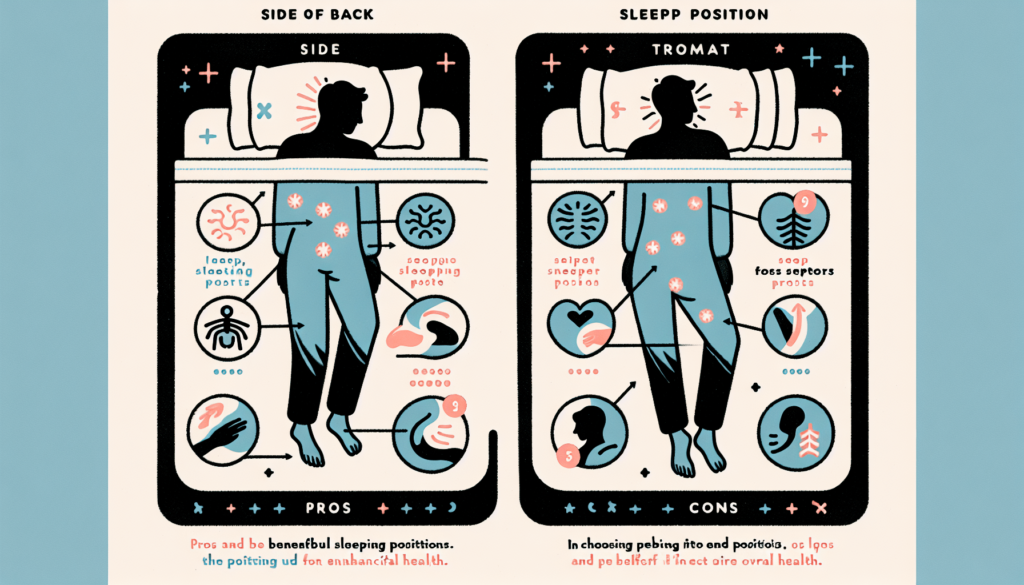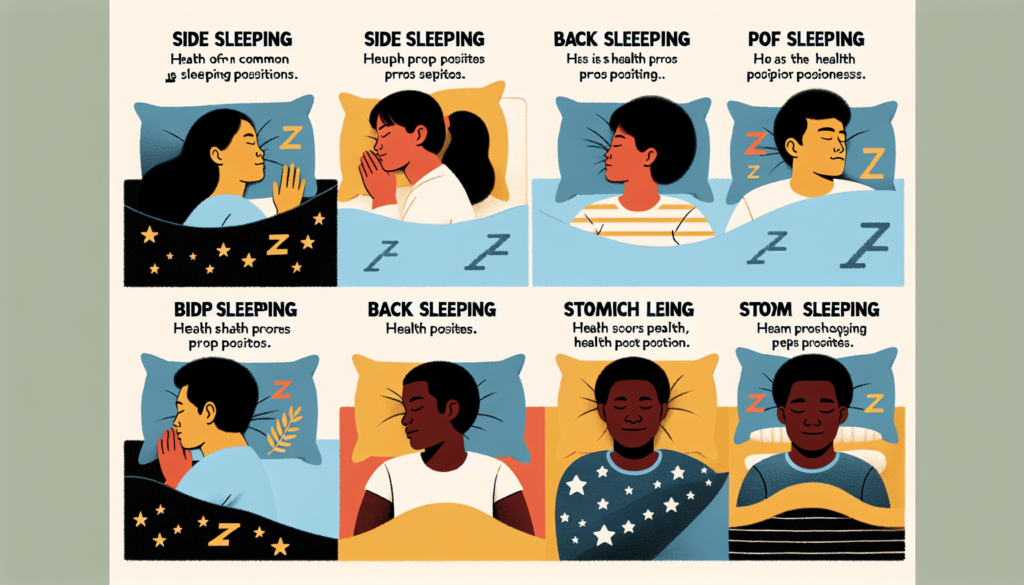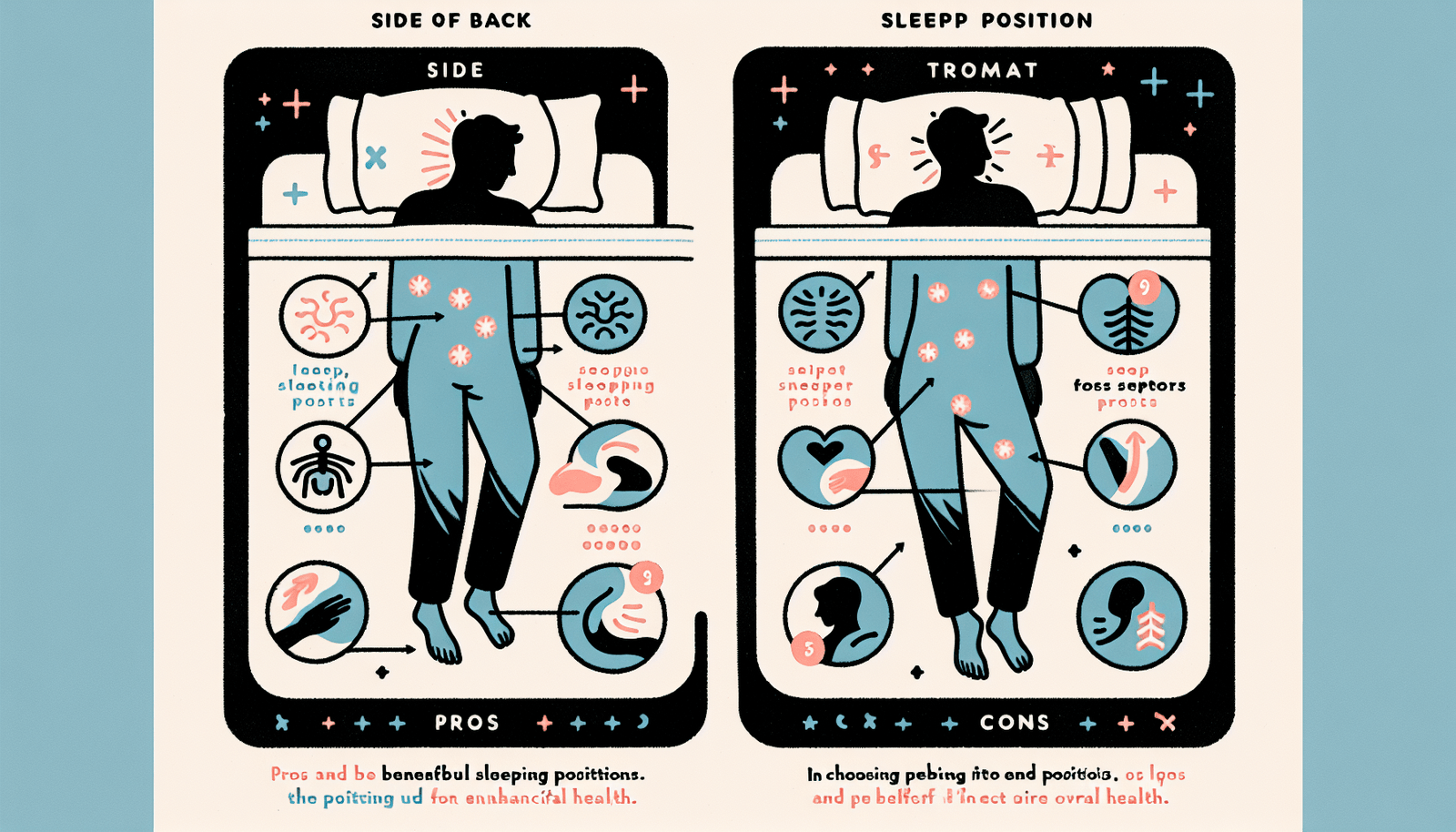Have you ever wondered what the best sleeping position is for your health? It’s a question that has probably crossed your mind at some point, especially if you’re someone who values a good night’s sleep. But with so many articles and opinions out there, it can be overwhelming to sift through all the information. Luckily, we’ve done the research for you. In this article, we will discuss the best sleeping positions for your health and the benefits they can provide. So let’s get straight into it and find out how you can improve your sleep and overall well-being.

Back Sleeping Position
Benefits of Back Sleeping
Sleeping on your back can offer several benefits for your health. Firstly, it helps to keep your spine aligned and reduces the risk of developing back and neck pain. This position allows your body to distribute weight evenly, relieving pressure on specific areas. Back sleeping may also minimize the risk of developing wrinkles and acne, as your face is not in direct contact with a pillow or mattress. This position can also help prevent acid reflux and heartburn, as gravity works in your favor to keep stomach acid down. Additionally, sleeping on your back can reduce the likelihood of waking up with a sore throat, as it allows your airways to remain clear throughout the night.
Tips for Sleeping on Your Back
If you want to start sleeping on your back, there are a few tips that can help make the transition more comfortable. Firstly, choose a supportive pillow and mattress that promote proper spinal alignment. It’s important to keep your head and neck supported to prevent strain. You can also try placing a small pillow or rolled-up towel under your knees to alleviate pressure on your lower back. Experiment with different pillow heights to find the most comfortable position for your neck. As a precaution, avoid using a pillow that is too high, as it can strain your neck and cause discomfort.
Potential Issues with Back Sleeping
While back sleeping offers numerous benefits, it may not be suitable for everyone. One potential issue is that sleeping on your back can worsen snoring and sleep apnea symptoms. If you or your partner suffer from these conditions, it may be best to explore other sleeping positions. Additionally, some people find it difficult to maintain the back sleeping position throughout the night, as they tend to roll onto their side or stomach unknowingly. If this is the case, it may be helpful to use pillows or props to keep yourself in place.
Side Sleeping Position
Benefits of Side Sleeping
Sleeping on your side is a popular position for many individuals due to the numerous benefits it offers. Firstly, side sleeping can relieve pressure on your back, making it a great option for those with back pain. This position promotes proper spinal alignment and reduces the risk of developing sleep-related discomfort. Side sleeping may also be beneficial for people who snore or suffer from sleep apnea, as it helps keep the airways open. Additionally, side sleeping can prevent acid reflux by keeping the stomach acid down and reducing the likelihood of it flowing back into the esophagus.
Tips for Sleeping on Your Side
To maximize the benefits of side sleeping, it’s important to maintain proper alignment and support for your body. Start by choosing a supportive pillow that keeps your head and neck in a neutral position. It should fill the gap between your neck and mattress, ensuring that your spine remains straight. Additionally, use a body pillow or place a pillow between your knees to keep your pelvis in alignment and reduce strain on your lower back. If you experience shoulder pain while side sleeping, try switching sides or using a pillow that provides extra support for your shoulder.
Potential Issues with Side Sleeping
Although side sleeping offers various benefits, there are a few potential issues to consider. Sleeping on your side can occasionally cause shoulder and hip pain, especially if your mattress is too firm or inadequate in providing support. It may be necessary to invest in a quality mattress and ensure that it offers proper cushioning and alignment for your body. Additionally, side sleeping can sometimes lead to skin wrinkles and facial creases due to the pressure exerted on the face. If this is a concern, using a silk or satin pillowcase may help reduce friction and prevent these unwanted marks.
Stomach Sleeping Position
Benefits of Stomach Sleeping
Sleeping on your stomach can provide relief for people who snore or suffer from sleep apnea. This position helps keep the airways open, reducing the likelihood of obstruction and promoting uninterrupted breathing. Stomach sleeping may also alleviate symptoms of acid reflux, as gravity helps keep stomach acid down. Additionally, some individuals find it easier to fall asleep and stay asleep in the stomach sleeping position, as it gives them a sense of comfort and security.
Tips for Sleeping on Your Stomach
To enhance your comfort while sleeping on your stomach, consider using a thin pillow that supports your head without tilting it upward. A pillow that is too high can strain your neck and cause discomfort. Alternatively, you can choose to forego using a pillow altogether, allowing your neck to remain in a more natural position. Additionally, using a soft and supportive mattress can help prevent the development of pressure points and provide optimal comfort when sleeping on your stomach.
Potential Issues with Stomach Sleeping
While stomach sleeping can have its benefits, it is important to be aware of the potential issues associated with this position. Sleeping on your stomach can strain your neck and spine, leading to neck and back pain over time. It can also cause pressure on nerves, resulting in tingling or numbness in your extremities. Furthermore, stomach sleeping can contribute to the formation of wrinkles on your face and the development of acne, as your face is pressed against the pillow for an extended period. If you experience any discomfort or notice skin issues, it may be worth considering alternatives.

Fetal Position
Benefits of Fetal Position
The fetal position, where you sleep curled up on your side with your knees drawn towards your chest, is a popular sleeping position that offers a sense of comfort and security. Sleeping in the fetal position can help alleviate snoring and sleep apnea symptoms by keeping your airways open and reducing the risk of obstruction. It can also prevent acid reflux by encouraging the flow of stomach acid away from the esophagus. Additionally, sleeping in this position can promote healthy digestion and improve circulation throughout the body.
Tips for Sleeping in the Fetal Position
To ensure you maximize the benefits of sleeping in the fetal position, it’s important to maintain proper alignment and support for your body. Start by using a supportive pillow that fills the gap between your neck and the mattress, providing adequate support for your head and neck. Additionally, consider placing a soft pillow or folded blanket between your knees to maintain alignment and reduce strain on your hips and lower back. Experiment with different pillow heights and levels of knee support to find the most comfortable position for your body.
Potential Issues with the Fetal Position
While the fetal position offers various advantages, there are a few potential issues to consider. Sleeping in this curled-up position can occasionally lead to joint stiffness and pain, especially in the morning. If you experience any discomfort, it may be beneficial to stretch and move your body upon waking to alleviate stiffness. Additionally, sleeping in the fetal position can restrict your breathing if your body is curled up tightly. If you find it difficult to breathe comfortably, try elongating your body slightly to allow for better airflow.
Pillow Support
Choosing the Right Pillow
Selecting the right pillow is essential for maintaining proper alignment and providing adequate support for your neck and head. When choosing a pillow, consider its firmness and material. A pillow that is too soft may not provide enough support, while one that is too firm can lead to neck pain. Ideally, look for a pillow that is medium-firm and made from materials that offer both comfort and breathability, such as memory foam or latex. It’s also important to choose a pillow that matches your sleeping position, as different positions require varying levels of support.
Positioning Your Pillow for Optimal Support
Once you have chosen the right pillow, it’s important to position it correctly for optimal support. When sleeping on your back, place the pillow under your neck and head, making sure it fills the gap between your neck and the mattress. This helps keep your spine aligned and prevents unnecessary strain. If you prefer to sleep on your side, choose a pillow that is thick enough to support the space between your shoulder and ear. Lastly, when sleeping on your stomach, consider using a very thin pillow or none at all to avoid straining your neck.
Mattress Choice
Firmness Level and Support
Selecting the right mattress is crucial for maintaining proper spinal alignment and providing adequate support for your body. When choosing a mattress, consider its firmness level and support capabilities. A mattress that is too soft can lead to misalignment of the spine and cause discomfort, while one that is too firm can create pressure points and result in pain. The ideal firmness level depends on your individual preferences and sleeping position. Generally, medium-firm mattresses tend to provide good support and alleviate pain for most people.
Considerations for Different Sleeping Positions
The best mattress for you will depend on your preferred sleeping position. Back sleepers typically benefit from a firmer mattress that promotes spinal alignment. This helps distribute their body weight evenly and prevents discomfort. Side sleepers generally require a mattress that contours to their body, relieving pressure points and ensuring their spine remains straight. For stomach sleepers, a mattress with medium firmness is recommended to prevent excessive sinking and maintain proper alignment. Ultimately, it’s important to choose a mattress that feels comfortable and supports your individual needs.
Sleeping Position and Sleep Disorders
Sleep Apnea and Sleep Position
Sleep apnea is a sleep disorder characterized by interruptions in breathing during sleep. The position in which you sleep can have a significant impact on the severity of sleep apnea symptoms. Back sleeping tends to worsen sleep apnea, as it can obstruct the airways and lead to throat and tongue blockage. Side sleeping, particularly on the left side, helps keep the airways open and reduces the risk of obstruction. If you suffer from sleep apnea, it is advisable to consult with a healthcare professional to determine the best sleeping position and explore treatment options.
Snoring and Sleeping Position
Snoring is a common issue that can disrupt both your own sleep and that of your partner. The position you sleep in can affect the intensity of snoring. Back sleeping is often associated with increased snoring, as it promotes the collapsing of the throat and obstructed airflow. Side sleeping, particularly on the left side, helps keep the airways open and can reduce the intensity and frequency of snoring. If snoring continues to be a problem, it may be worth consulting with a healthcare professional for further evaluation and potential treatment options.
Restless Leg Syndrome and Sleeping Position
Restless Leg Syndrome (RLS) is a condition characterized by an uncontrollable urge to move the legs, often accompanied by uncomfortable sensations. While sleep positions do not directly influence RLS, they can affect the overall quality of sleep. Individuals with RLS may find that certain positions, such as sleeping on their side or with their legs slightly elevated, provide relief from the symptoms and allow for better sleep. It is important to discuss any concerns related to RLS with a healthcare professional to explore appropriate management strategies.
Pregnancy and Sleeping Position
Recommended Sleeping Positions during Pregnancy
During pregnancy, it is important to choose sleeping positions that provide optimal comfort and support for both you and your baby. The recommended sleeping position for pregnant women is sleeping on the side, particularly the left side. This position helps improve circulation, allowing for better blood flow to the uterus and kidneys. It also alleviates pressure on major blood vessels, reducing the risk of edema and swelling. Sleeping on the left side can also help prevent acid reflux and heartburn by keeping the stomach acid down.
Safest Positions for the Baby
Sleeping on your left side during pregnancy also benefits the baby. This position improves blood flow to the placenta and helps ensure a sufficient oxygen and nutrient supply. It can also reduce the risk of stillbirth by minimizing the compression of major blood vessels. While sleeping on the back is generally considered safe during the earlier stages of pregnancy, it is advisable to switch to side sleeping by the second trimester to avoid potential complications. If you have any concerns or questions about the safest sleeping positions for your baby, consult with your healthcare provider.
Comfort Tips for Pregnant Women
To enhance your comfort and promote quality sleep during pregnancy, consider using additional pillows for support. Place a pillow between your knees to relieve strain on your hips and back, and use a pregnancy pillow or wedge to support your growing belly. Experiment with pillow placement and different sleeping positions to find what works best for you. It may also be helpful to sleep in loose, comfortable clothing and keep your bedroom cool and well-ventilated for optimal sleep conditions. If discomfort or sleep disturbances persist, consult with your healthcare provider for further guidance.
Sleeping Position and Neck/Back Pain
Alignment of Spine and Neck
Proper alignment of the spine and neck is crucial for preventing and alleviating neck and back pain. Sleeping in the right position can help maintain alignment and reduce discomfort. Back sleeping provides excellent spinal alignment, as it allows your body to rest in a neutral position. Side sleeping can also be beneficial for relieving back pain, as it helps align the spine and alleviate pressure on specific areas. Stomach sleeping, on the other hand, can strain the neck and spine, leading to pain and discomfort. It is important to find a position that works best for you and supports your individual needs.
Positioning for Pain Relief
If you experience neck or back pain, there are a few positioning strategies that may help alleviate discomfort. When sleeping on your back, use a pillow that supports the natural curve of your neck and keeps your spine aligned. Placing a pillow or rolled-up towel under your knees can help relieve pressure on your lower back. For side sleepers, use a pillow that fills the space between your ear and shoulder, keeping your head and neck aligned with your spine. Additionally, consider placing a pillow between your knees to reduce strain on your hips and lower back.
Other Considerations for Healthy Sleep
Sleep Hygiene Practices
In addition to choosing the right sleeping position, practicing good sleep hygiene is essential for ensuring restful and rejuvenating sleep. Establishing a regular sleep schedule and sticking to it can help regulate your body’s internal clock and enhance the quality of your sleep. Creating a calm and comfortable sleep environment is also important. Make sure your bedroom is dark, quiet, and kept at a cool temperature. Limit exposure to electronic devices before bedtime, as the blue light emitted can interfere with your sleep. Additionally, avoid consuming stimulants, such as caffeine and nicotine, close to bedtime, as they can disrupt your sleep patterns.
Environment and Sleep
Creating a conducive sleep environment can significantly impact the quality of your sleep. Invest in a good quality mattress and pillow that provide optimal support and comfort for your body. Consider the firmness, material, and support capabilities of your bedding. Ensure that your bedroom is cool, dark, and quiet by using curtains, earplugs, white noise machines, or sleep masks as needed. Minimize distractions and create a relaxing atmosphere that promotes rest and relaxation. Taking these steps to optimize your sleep environment can help you achieve better sleep and overall well-being.
In conclusion, choosing the right sleeping position can have a significant impact on your overall health and well-being. Each sleeping position offers its own benefits and potential issues. Back sleeping promotes spinal alignment, while side sleeping can alleviate pressure points and reduce snoring. Stomach sleeping can help with sleep apnea and acid reflux, while the fetal position provides comfort and relief for pregnant women. It’s important to consider pillow support and mattress choice to ensure proper alignment and support for your body. Factors such as sleep disorders, neck/back pain, pregnancy, and sleep hygiene practices should also be taken into account. By understanding your individual needs and preferences, you can find the best sleeping position for your health and enjoy a restful night’s sleep.
